In the previous article, we’ve already skimmed over “gesture” and its confusing, loose definitions, such as “the flow of the form”. Some authors have even more peculiar use of the term, and will happily call a bunch of hasty scribbles “gesture”, while others will talk about “gesture” within a landscape.
We’ll dissolve the confusion progressively, by actually studying how can gesture, as a tool, be of use for a draftsman.
That being said, to help make things clear, from a practical point of view, one can think of gesture as composition lines, generally applied to the human figure.
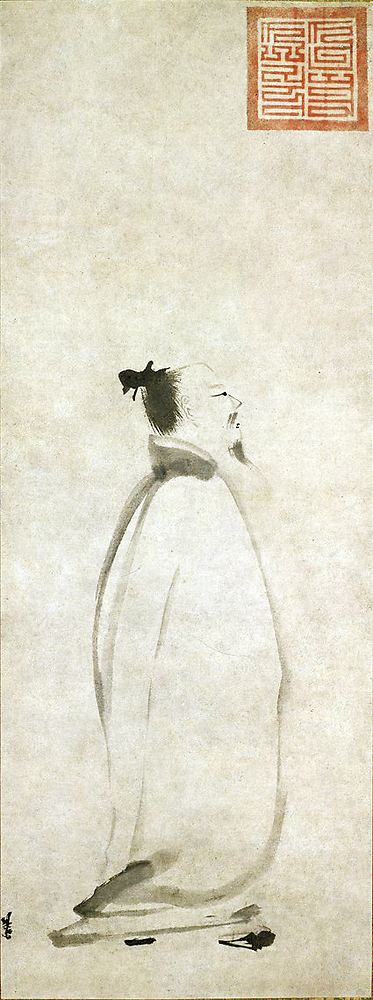
Li Bai (李太白) in stroll Song dynastie, 13th century by Liang Kai (1140-1210) 梁楷 through wikimedia.org – Public domain
Gesture usages
Without considering gesture as related to composition (let’s say you disagree), we can keep a foggy definition, and still come to develop an intuitive understanding of it by looking at how people who talk about gesture drawings are actually using them, in which context.
This may actually be the key point to understand gesture, regardless of which author one chooses to study from.
Some gesture drawings are kept as-is, but most often, they constitute a first step in a more complete drawing. As such, they can be used to:
- help positioning a drawing on the sheet;
- establish general proportions.
In particular, for animators, they can help design the action flow, from one frame to another, without getting distracted by the details.
Especially when working from imagination, or when developing an artwork, because in essence, gesture lines can be used as composition lines, and more generally, to compose. Because we’re in the realm of the human figure, and because of the structure of the human body, those composition lines mainly arise from the balancing of the various masses of the body (head, thoracic cage, pelvis, etc.) against gravity.
From a practical point of view, they are also a way to record the main elements of a pose quickly, and more generally to sketch around, especially moving subjects.
As a teaching aid, gesture drawings are often recommended to beginners, whose work tends to be too stiff; it’s often advised to emphasize the bending and twisting, the movement, when doing gesture.
Exercise: In the examples below, the reader is encouraged to see how different artists are applying some of the previous points in their creative process.
Examples
Huston, Proko: CSI
Perhaps the most iconic form of gesture is the one relying on a few swift lines, as explained in the following:
Those drawings are most often solely made using C-curve, S-curve and straights (“I”, hence the CSI denomination). The resulting gesture drawings tend to become harmonious: this is an example of application of the unity in diversity principles that we brushed upon in the composition article.
Note: There isn’t one way to use CSI lines to represent a given pose: that potential of variety allows to alter the general feel of a pose. Artists can try to keep that feeling in a more refined drawing; that’s where deviating from the model is useful.
Most often, no tone or form indication are added, as gesture is generally used as foundation for further work, but it’s not absolute: in the following, Steve Huston is using a bit of tone and a few cross-contour lines to help convey a minimalistic sense of form:
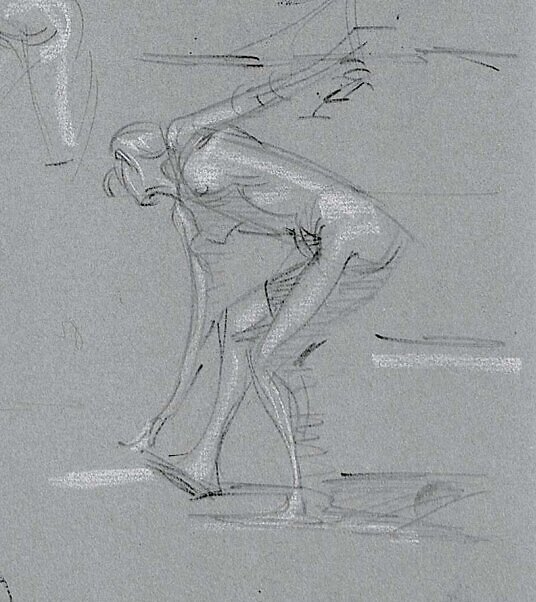
An example of gesture, from the book Figure Drawing for artists, p.39
by
Steve Huston
Watts: Reilly rhythms
Reilly rhythms describes a set of lines, specially designed so that their interconnection matches a few major volumes of either the face, or of the whole figure. While those lines, those rhythms, don’t necessarily apply well to all poses, they still offer an interesting general option.
Those rhythm, when applied to the figure, in the hand of experienced draftsmen, will help help produce a solid foundation for further work with little effort. Contrary to the previous ones, those drawings are more cautious, and put a stronger emphasis on anatomy. But, they still rely on the same CSI lines.
Beyond the scope of this article, but interesting to better understand those rhythms, below is the archetypal, funny-looking version of those, applied to the face; you can see how they actually correlate to major anatomical details, and get an idea on how they can be used in practice for portraiture. Essentially, the same principles apply to the full figure.
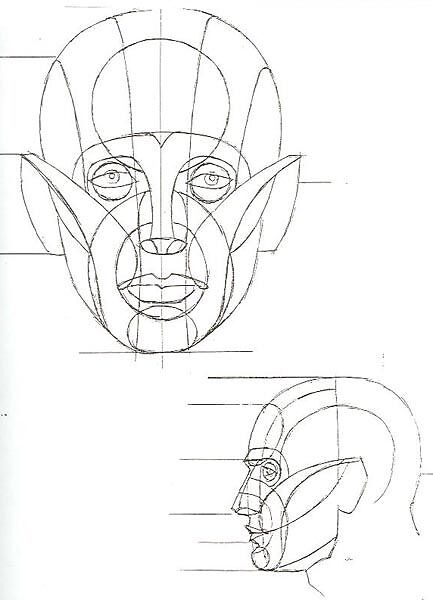
Reilly rhythms of the face through pinterest.com – likely, available for fair use
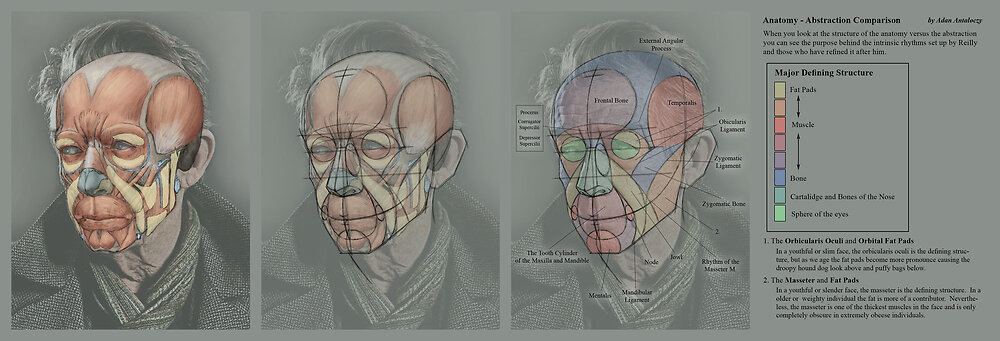
Reilly rhythms of the face, correlated with anatomical details
by
Adam Antaloczy
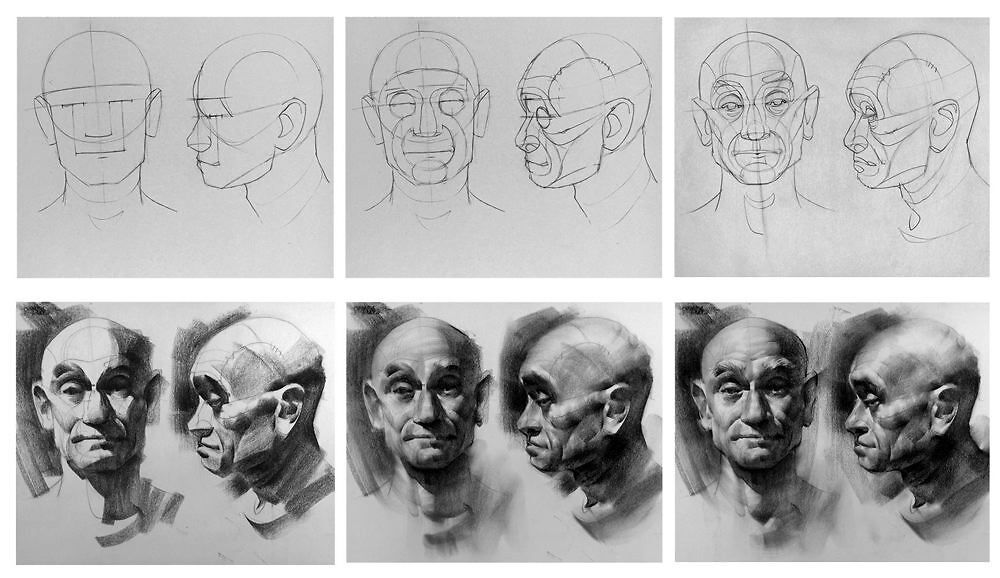
Reilly rhythms of the face, from How to Draw Portraits in Charcoal
by
Nathan Fowkes
Note: Unrelated to the topic of gesture, but the following blog contains various teaching material from Frank J. Reilly, mainly related to painting.
Nicolaides, The Natural Way to Draw: scribbles
While visually very different from what we’ve seen before, Nicolaïdes still describes “gesture” in a similar way as previous authors:
On the other hand, gesture drawing, which you will begin today, is to be done ‘furiously.’
[…]
In long studies you will develop an understanding of the structure of the model, how it is made - by which I mean something more fundamental than anatomy alone. In quick studies you will consider the function of action, life, or expression - I call it gesture.
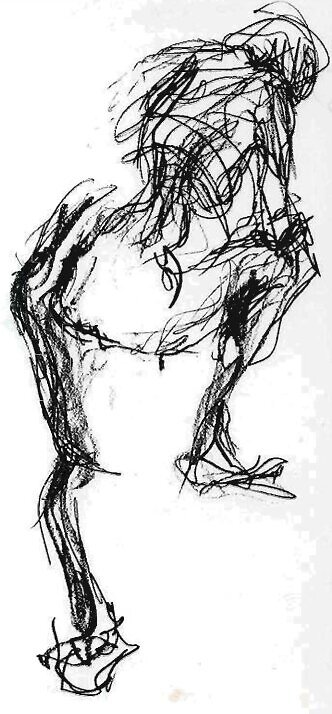
Gesture example, as seen on the cover of The Natural Way to Draw
by
Kimon Nicolaïdes (1891–1938)
However crude it may look, such a rough “drawing”, for lack of better word (Nicolaïdes insists on differentiating between “quick studies”, that is gesture, and “quick sketches”), can still be used as a rough placement, for further work, and still do communicate the idea of the pose. Visually, they are close to what we’ve saw in the previous article with Marco Bucci’s video on character design:
Hampton, Finch: “constructed” gesture
In previous examples, “gesture” was approached very loosely, but you can find some authors who will start to infuse much more form information/anatomical ideas within what they will call “gesture”.
Michael Hampton still keep a loose visual output, close to Steve Huston’s, but relies on anatomical terminology and knowledge to systematize/normalize his gestures, which can be highly relevant to help confused students.
David Finch pushes the idea even further, and will consider a small mannequin to be a “gesture”. Likely, an influence of his background as a comic artist.
KJG, academists: tacit
Gesture isn’t mandatory, and some people do fine without (explicitly) relying on gesture drawings, like people who draw directly, or some academists:
But both need and use, either in their mind or on the side, consciously or not:
- a way to place the figure on the surface;
- a way to compose the drawing;
- a way to establish proportions.
Researchers: a target for a subset of the kinematic chain from a particular viewpoint
To conclude on an “amusing” note, some researchers have built software allowing to automatically pose a mannequin from lines of action. They encountered the same issue regarding the looseness of “gesture” definition, for their purposes a rigorous definition being mandatory.
(link to the paper (pdf), 2013)
Comments
By email, at mathieu.bivert chez: